I may receive a commission if you purchase through links in this post. I am not a doctor; please consult your practitioner before changing your supplement or healthcare regimen.
Gluten Free Vegan Oat Bread contains no potato-based flours (such as arrowroot, tapioca or cassava), no yeast, no flax and no gums. This allergy-friendly bread is soft, rustic, easy to make and delicious.
This recipe is also VAD-friendly.
If you’re like me, you’ve looked at the ingredients in store-bought gluten-free breads and been SO disappointed. Almost all of them use gluten-free flour mixes that combine grains and potatoes (= hard to digest), vegetable oils (disease causing) or additives that should not be part of our whole food diets.
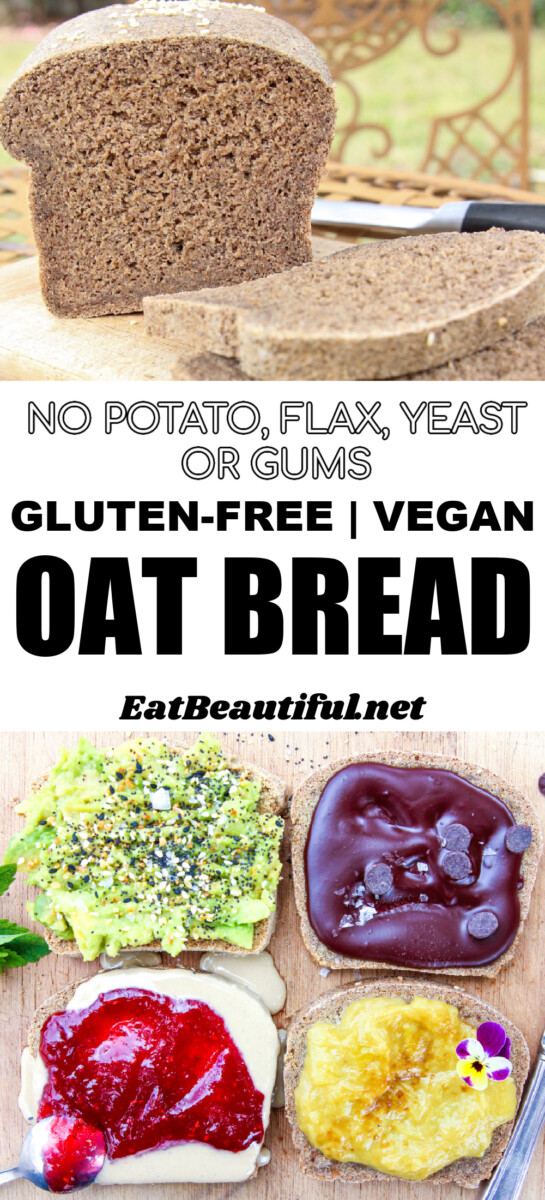
I’m at a stage in my cooking life when I enjoy nothing more than making a loaf of bread!
I find it so filling emotionally — the whole experience. But my favorite part is scraping the batter into the loaf pan and sliding the pan into the hot pre-heated oven.
I love the sense of accomplishment and knowing I get to please and nourish my family with a fresh loaf of bread — with only the purest of ingredients.
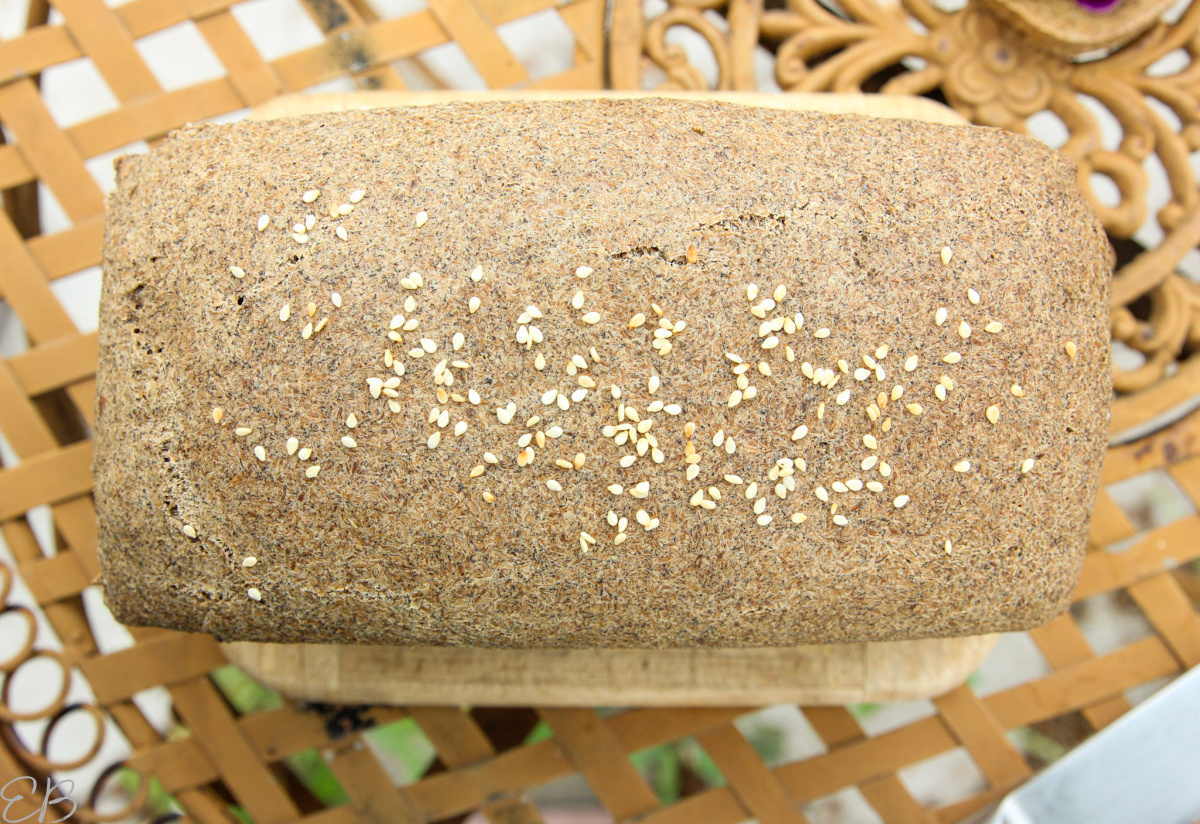
What to serve on Vegan Gluten Free Oat Bread
I also like thinking about what we’ll put on Gluten Free Vegan Oat Bread.
- nothing at all — This bread’s texture is super soft, tender and moist. It’s delicious by itself.
- Berry Jam or Rhubarb Sauce — In the photo below, you can see the yellow-green version of Beautiful Rhubarb Sauce, soo lovely with spring or summer rhubarb.
- butter or coconut oil — Depending on your diet … put this on warm bread and watch it slowly melt. I love eating warm bread with partially melted fat.
- Chocolate Ganache — This spread takes just 5 minutes to make, and you’ll LOVE it.
- smashed avocado for Avocado Toast
- open-faced veggie, meat or cheese (for non-vegan) sandwiches; or closed-face
- nut, seed or peanut butter
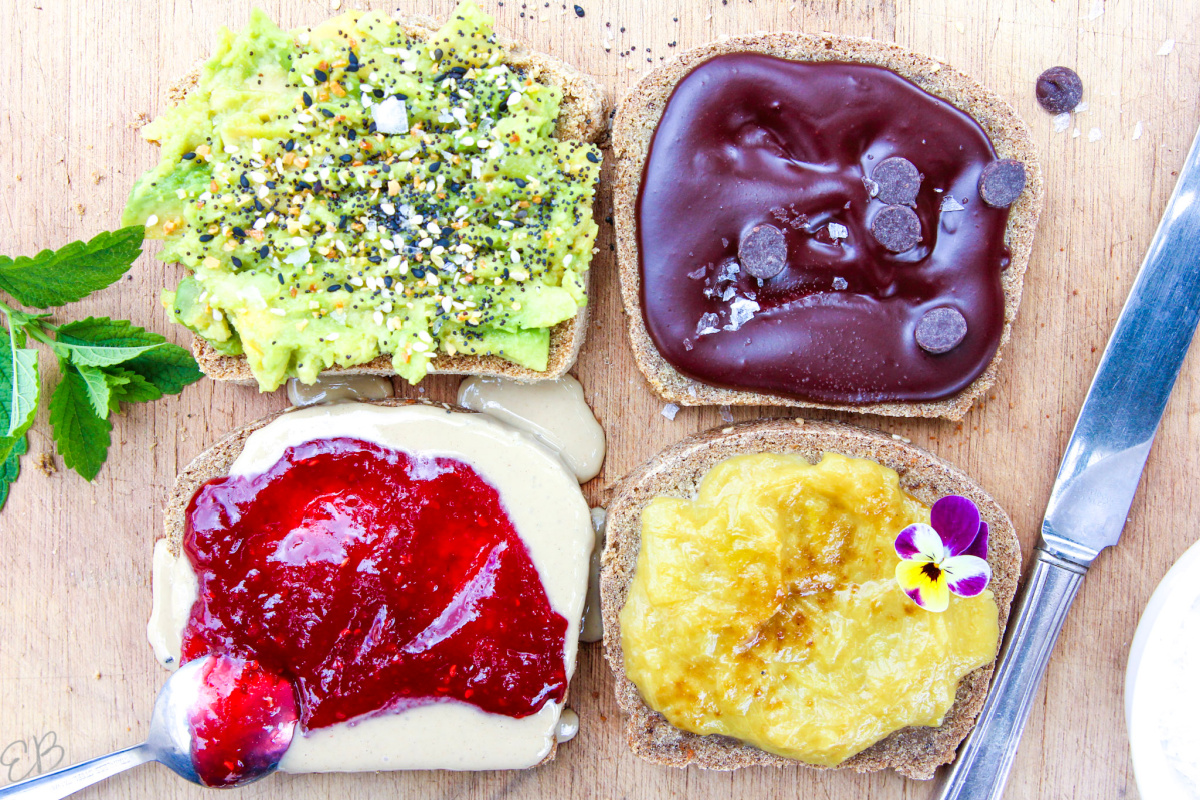
Potato-free Gluten Free Oat Bread
Gluten Free Vegan Oat Bread is free of yeast, gums, dairy, refined sugar, refined oil, flax and potato!
No potato means: potato starch, arrowroot, tapioca or cassava (all in the potato family). Even most baking powders contain potato. If you need 100% potato-free bread, be sure to use Rumsford brand, which is potato-free.
Most gluten-free bread loaves (and gluten-free flour mixes) combine rice flour with tapioca or potato flour. Yet roughly half of the population does not digest potatoes and grains well when eaten together.
Gluten Free Vegan Oat Bread uses oat flour combined with your choice of rice flour or another favorite such as millet or buckwheat flour.
The result is a tender crumb + a delicious, gentle-to-digest slicing bread for sandwiches, toast or any other bread needs.
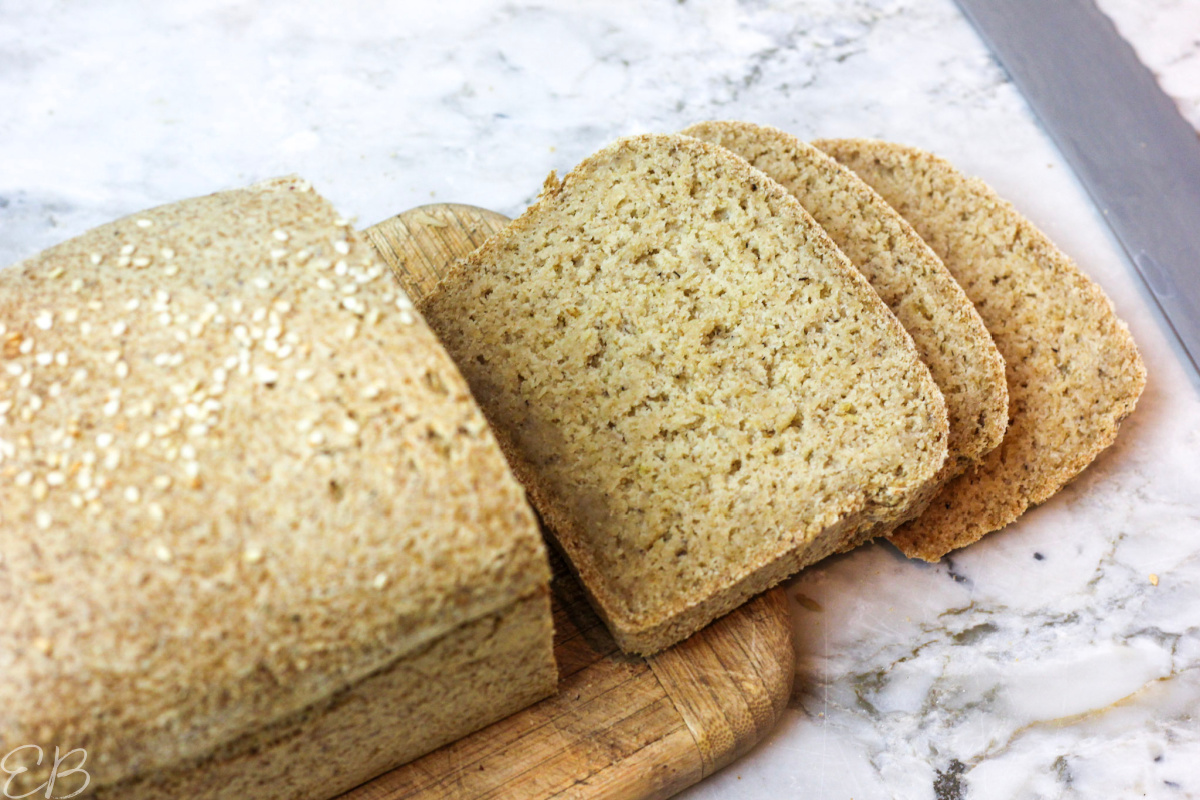
Allergy-friendly ingredients
No gums means: no xanthan gum, because it’s problematic for some people and not safe for babies.
I omitted flax seed meal from this bread, although it performs well in egg-free recipes. It is high in phytoestrogens, so not ideal for many bodies.
Nightshade-free benefits
While I personally enjoy potatoes, the other advantage of keeping potato starch out of gluten-free bread recipes is: This recipe is nightshade-free. For those who get inflammation from potatoes, this recipe is safe.
(And most potato starch on the market is sourced conventionally; potatoes belong to the list of Dirty Dozen produce items — that are full of pesticide residues and should only be consumed organic. So all that conventionally grown gluten-free bread … not so good.)
Vegetable oil free
Sadly, many commercially-made gluten-free breads now contain vegetables oils!
If you don’t already know, vegetable oil is THE leading cause of heart disease. Just as bad, if not worse, than white sugar, vegetables oils should ALWAYS be avoided. I no longer even eat French fries at “gourmet” restaurants if they’re cooked in vegetable oil. It’s a dangerous “food”.
So, it’s awesome to make our own breads, friends!! SO awesome. We get to choose what beautiful whole food ingredients go into our bread — and control our organic ingredients, our diet and steer our own health journey!
And, we get the experience of baking and eating homemade bread — which adds wonder and joy to life.
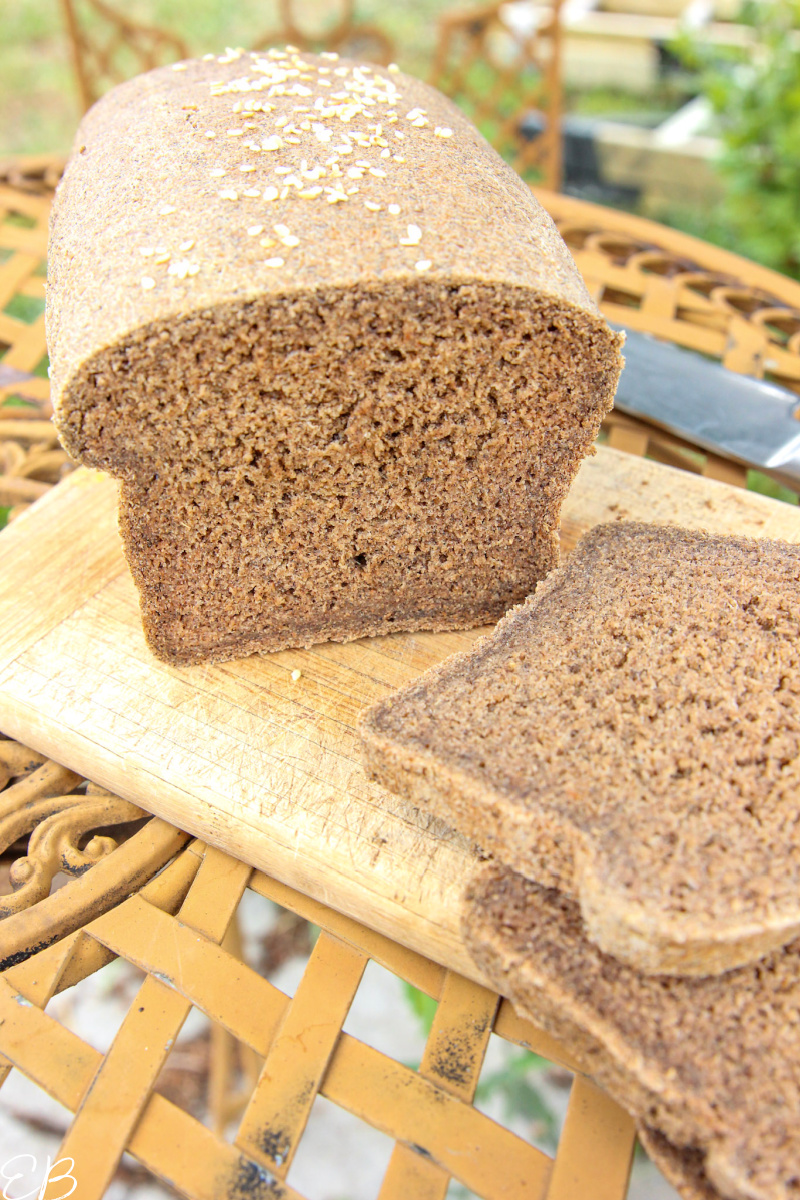
Ingredients in Gluten Free Vegan Oat Bread
Gluten-free Oat Bread is mixed just like a loaf of “quick bread”. No yeast, kneading or waiting for it to rise.
The main ingredients you’ll need are:
- Oat flour — High in both soluble and insoluble fiber, oat flour is great for regularity, satiety and even blood sugar levels. It’s also high in B vitamins (especially Vitamin B1) and minerals.
- Buckwheat flour or White rice flour — Or millet flour. IMPORTANT: Choose this secondary flour based on what you like the taste of — OR — your nutritional needs, whichever is more important to you.
- For example, white rice flour creates the most traditional and mild tasting bread. It isn’t the healthiest, but the main flour (oat) is very healthy, so not a big deal.
- If you really want the entire loaf to be super nutrient-dense, choose buckwheat or millet flour. Buckwheat has a really strong flavor, so don’t choose it unless you know you like it. You may also use part rice and part buckwheat etc.
- Psyllium husk whole— Psyllium comes from a shrub-like herb called Plantago ovata. Each plant produces over 10,000 little seeds. Psyllium husk is a soluble fiber made from the husks of the seeds — that helps with regularity and is prebiotic. PHP is often used in Keto and Gluten-free baking because it has zero net carbs and helps to create a light, nice bread texture! Be sure to buy psyllium whole (like this), not powder. (Update, I recommend you specifically use the brand linked to here or in the recipe below, to ensure recipe success. Other brands vary too much, and some readers have ended up with a dense loaf.)
Psyllium whole husk fiber is a great alternative to other flours that are harder to digest. Plus, it holds the bread together well, in the absence of gluten and eggs.
The remaining ingredients in Vegan Gluten Free Oat Bread are:
- Water — To measure the water, use a liquid measuring cup. A warm water temperature is helpful to this recipe; it keeps the solid fat warm (instead of congealing) but isn’t too hot (which isn’t good for the baking soda). I chose to create this recipe with water instead of milk to create a less expensive and easier to source recipe.
- Coconut oil or butter — If you’re Vegan or dairy-free, choose coconut oil. Otherwise, I like to use Kerrygold butter. Solid melted fat adds moisture to this bread and helps to create the right “crumb”. (Update: Some readers have had fine success also using avocado oil, or similar natural oils.)
- Liquid sweetener — I suggest maple syrup in the recipe below. But you may also use brown rice syrup or agave, if you prefer.
- Vinegar — Choose from apple cider, rice, or even use lemon juice. This acid reacts with the baking soda to create a natural chemical rise in the bread dough.
- Baking soda and baking powder — Two leavening agents are used for the bread’s rise. Be sure yours are fresh.
- And sea salt — For just the right flavor.
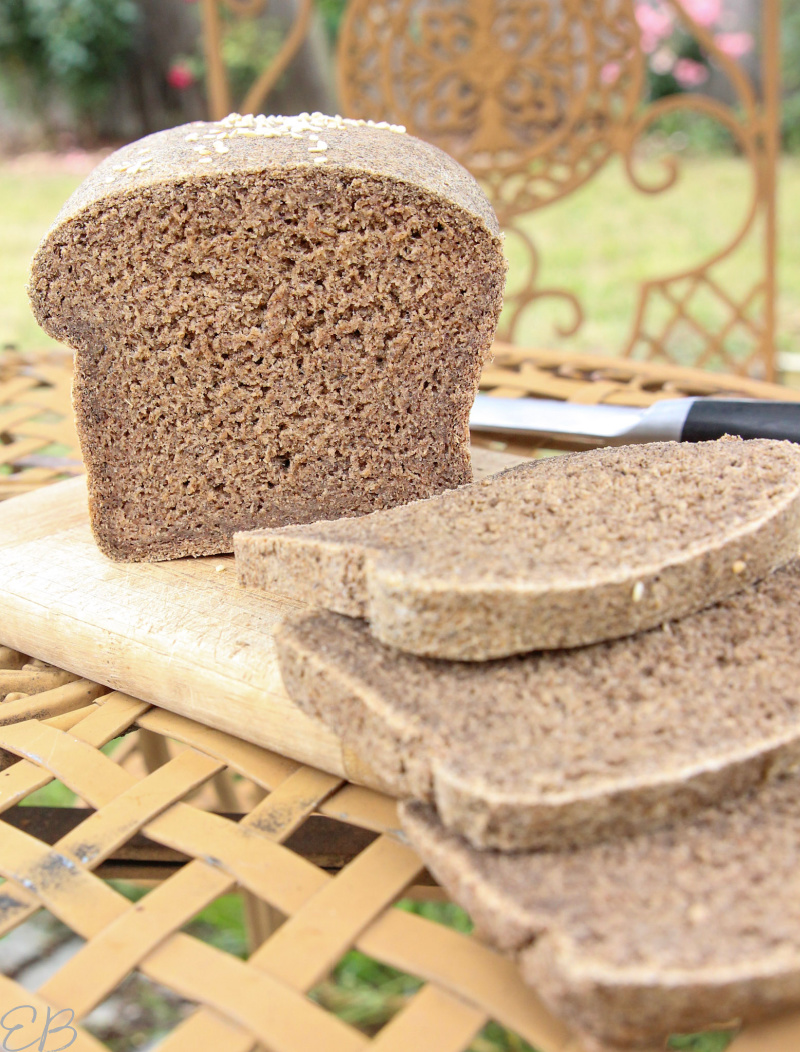
How to make Gluten-free Oat Bread
Gluten-free Vegan Oat Bread is REALLY easy to make. It’s a one bowl recipe. But, you can also put the dry ingredients in one big bowl and the wet ingredients in a smaller bowl first, if you prefer.
If you use just one bowl, be sure to pre-measure all the wet ingredients, so they’re easy to add to the big bowl one after the other.
Here’s how it goes:
- Place all dry ingredients in large mixing bowl. Stir briefly to combine.
- Add wet ingredients.
- Use handheld electric beaters (or an electric mixer) to fully mix dough. It will be thin at first and then become thick dough as it sits for a minute.
- Transfer dough to prepared loaf pan.
- Wet your fingers with water, and rub them over the surface of the bread to smooth and shape it. Repeat this a few times.
- Bake in preheated oven for 50 to 60 minutes.
How to make Gluten-free Oat Bread into sourdough
If you want to get the maximum nutrition out of this bread, the best thing to do is give it an overnight ferment!
You don’t need a sourdough starter to ferment this bread. Instead, we’ll add a probiotic liquid in place of some of the water in the recipe, and that will help to “pre-digest” the oats and buckwheat (or millet).
To get technical, very briefly, buckwheat contains an enzyme that helps to break down oats. So if you plan to make the sourdough version of this recipe, I recommend using at least part buckwheat (instead of using rice or millet flour in its place).
You may use as little as 1/4 cup buckwheat flour to assist the pre-digestion process.
WHICH PROBIOTIC LIQUID TO USE
Choose any probiotic liquid you have on hand. Here are some probiotic liquid ideas:
- sauerkraut juice (better to use a plain tasting one than one with garlic etc, unless you want garlic-tasting bread)
- water kefir
- kombucha
- whey — Strain this from any yogurt, including non-dairy yogurt.
- actual gluten-free sourdough starter
HOW TO MAKE SOURDOUGH WITH THIS RECIPE
This recipe calls for 2 cups of water. You’ll take some of the water out, and sub in the probiotic liquid in its place.
Sub in just 1/4 cup of the liquid, if you have time to ferment the loaf overnight.
If you want to sour the dough more quickly, use a larger ratio of probiotic liquid, up to 1 cup.
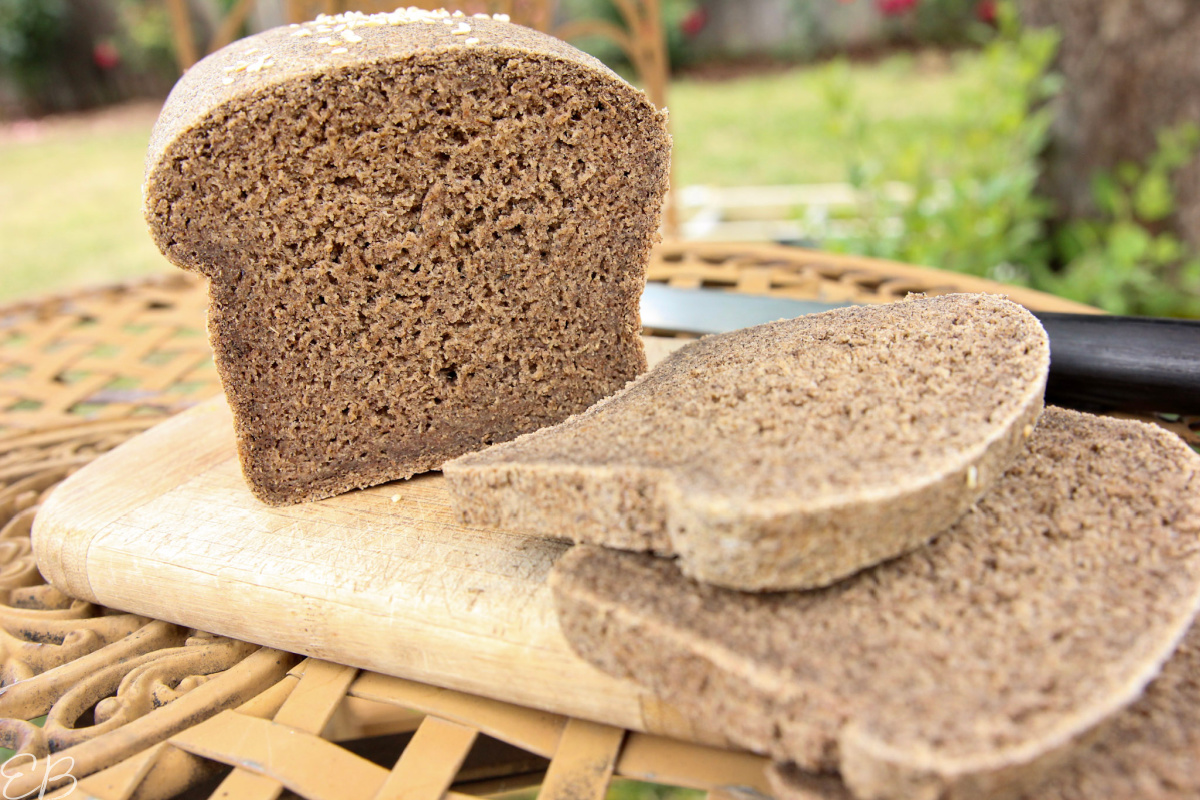
Gluten-free Vegan Oat Bread (Yeast & Potato-free)
Equipment
- hand held electric beaters or other electric mixer
- bowl
- oven
Ingredients
- 2 ¼ cups water (For Sourdough version, see recipe Notes: sub in ¼ cup minimum probiotic liquid.)
- 2 cups oat flour (220 grams)
- 1-¼ cups psyllium husk whole , NOT powder: I recommend you specifically use the brand linked to here, to ensure recipe success. Other brands vary too much, and some readers have ended up with a dense loaf. (81.25 grams)
- 1 cup white rice flour (150 grams); OR buckwheat flour or millet flour; or masa
- ¼ cup coconut oil or butter, melted
- 3 Tablespoons maple syrup
- 2 Tablespoons apple cider vinegar , rice vinegar or lemon juice
- 1 Tablespoon baking powder (11 grams)
- 1 teaspoon baking soda (3 grams)
- 1 teaspoon sea salt (3 grams)
Instructions
- Preheat oven to 375° Fahrenheit. Grease a loaf pan, or line with parchment paper, and set aside.
- In a large bowl, combine the dry ingredients: oat flour, rice or buckwheat flour, psyllium husk, baking powder, baking soda and sea salt. Stir briefly to mix.
- Pre-measure the liquid ingredients, so they're all ready (or combine them in a small bowl). Add the wet ingredients to dry ingredients: water, fat of choice, sweetener and vinegar. Use handheld beaters or other electric mixer to combine. Dough will be thin at first, but after mixing and sitting for a minute will become quite thick. Scoop into prepared loaf pan and shape to be slightly mounded in the center.
- Wet your fingers or the back of a spoon with water to rub and smooth the top surface. If you wish, dust with sesame seeds.
- Bake in preheated oven 50 to 60 minutes. To check for doneness, you may turn the loaf pan upside down to gently dump out the loaf, and give the bottom a light thump with your fist. The inside should sound hollow. Allow to cool on a rack for about 30 minutes before slicing.

- Store in an airtight container on the counter for up to 3 days, or in the fridge for up to 5 days. To freeze, you may wish to slice the bread first, to easily break off individual servings. Freeze for up to 3 months.
Notes
How to make Sourdough Gluten-free Vegan Oat Bread
Use probiotic living sauerkraut juice (or the probiotic liquid from another fermented vegetable) OR probiotic whey to make this recipe.- Proceed with the above recipe, as it is written, BUT sub ¼ cup sauerkraut juice or whey for ¼ cup of the water.
- When choosing between white rice flour, buckwheat flour and millet flour, use at least ¼ cup buckwheat flour for the gentlest digestion of the loaf.
- After your loaf is formed in the pan, cover it with a damp dish towel or wax cloth. Place in a warm location for 4 to 8 hours, or overnight.
- Preheat oven, and bake as the above recipe describes.
Nutrition
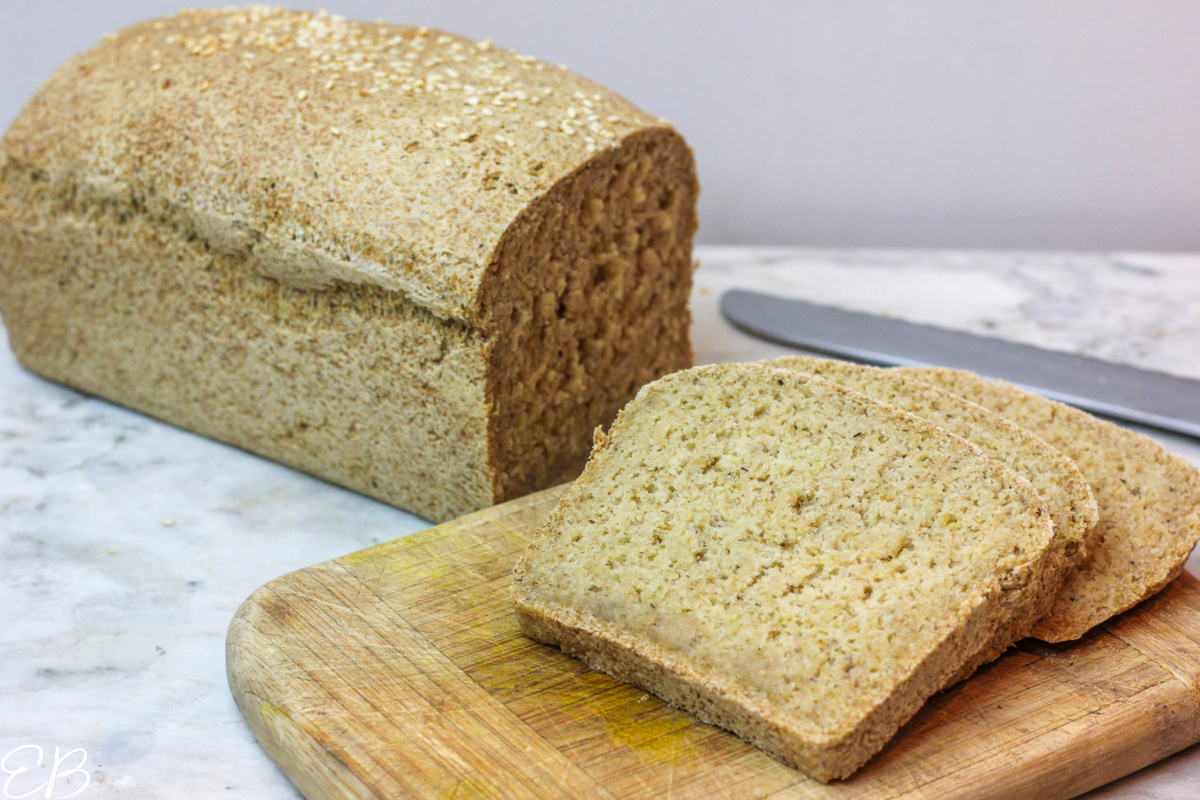
Similar Gluten-free recipes I think you’ll love:
- Easy Gluten-free Rice Bread (No potato, gums or yeast)
- Nutritious Bean & Oat Waffles (Vegan)
- Beans and Rice Flour Waffles (Vegan)
- Gluten-free Egg-free Waffles (Vegan, made with a lot of veggies)
- Best Easy AIP Bread Recipe (Egg-free, nut-free)
- Keto Vegan Bread Rolls
- Paleo Vegan Tiger Nut Pie Crust
- Chocolate Chip Cookies (Paleo, Vegan)
- Instant Pot Buckwheat Porridge
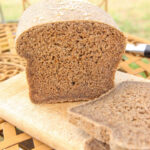
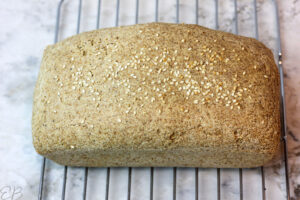

Sarabeth Matilsky says
I am curious to try this…but so far, some in my family seem intolerant of psyllium. I’ll try whole psyllium to see if that’s better than powdered…but did you really use 1 1/4 cups? ? thanks for all your great ideas!!
Megan says
Hi Sarabeth, you’re welcome and happy to help! Yes, truly 1-1/4 cups whole psyllium in the recipe. 🙂 (Does psyllium powder give them GI discomfort or ?)
Sarabeth Matilsky says
Yes, GI pain, gas, D…?
Megan says
Got it, yes. Well, I don’t think the whole psyllium will be any gentler for them then, at least for now. I’m sorry! Seems a bread recipe for you guys with egg whites as long as you’re getting enough B1 from other food sources might be a better bet.
Lanore says
Could I replace the psyllium husk whole with psyllium powder? I have powder on hand and don’t want to buy another thing if possible. Just wondering ratio conversion and if it would work??
Megan says
Hi Lanore, you’ll get an okay loaf of bread, probably, but I can’t be sure how perfect it will be. I understand your dilemma, though. For the loaf to turn out perfectly, the whole psyllium husk is needed. It will create a lighter loaf, as the powder is denser and measures differently. I haven’t tested the recipe with the powder to try and give you a conversion. Sorry!
Lynette says
Hello.
Can you replace the buckwheat with sunflower flour or almond flour?
Can one replace the syrup with honey?
Megan says
Hi Lynette, probably, but I haven’t tried them to know. It will change the texture a bit, but either flour sub will likely work. Keep in mind that any sunflower product contains chlorogenic acid in it; when that reacts with the baking soda, it creates green color throughout your bread. 😉 And yes, it’s okay to sub in honey, but it may create a darker crust.
Marsha says
My bread turned out somewhat flat and dense. The taste was great. I weighed all of the ingredients and the dough was really thick and not as moist as I thought it would be. I was expecting a thinner batter that would thicken up. It was just thick from the start. I used whole psyllium husk, oat flour and brown rice flour (didn’t have white), and one fourth cup of the rice flour I subbed with buckwheat. Any suggestions on what I can do to make it lighter/fluffier?
Megan says
Hi Marsha, what brand of psyllium husk whole did you use? And, I have not made this recipe with brown rice flour, so that may be the issue. You might consider the other flours I share instead.
Valerie S. says
Hi! This looks really good. I look forward to trying it this week. Thanks for always giving alternatives that work with your base recipes. I make coconut water kefir. Can I ferment with it for this recipe?
Megan says
Hi Valerie, you’re welcome and thank you! Yes, you can definitely use coconut water kefir for the sourdough version. Enjoy!
Sarah says
Trying this recipe today I’m so excited!! Would Oat flour AND cassava flour work??
Megan says
Hi Sarah, I’m sorry to get your question so late; it went into another folder. No, I don’t think it will turn out the same, because cassava has a stretchier outcome than the other flour options. But, it may still turn out nicely; I just can’t say for sure, as I haven’t tried it.
Alex says
Hi Megan,
This is a beautiful bread and a great recipe for those of us on the VAD diet! We are testing out buckwheat right now and hope to try oats next month, so we are moving along this detox journey slowly. This is definitely a bread we are excited to try once we are further along the detox. Thank you for sharing.
Megan says
I’m so glad, Alex, you’re welcome. 🙂 Thanks for commenting!
Sarah says
Hi! I followed your directions as closely as possible, but changed one thing. I made my own flours, so they are a bit coarse. The dough ended up needing like twice as much water and is kind of enormous and turning into a bread monster in my oven!
Megan says
Wow, Sarah. I think the size of your bread and the amount of water you used reflects the kind of psyllium husk you used, as that can balloon up, depending on the variety. If you make the bread again, I recommend using the variety I link to in the recipe. Thanks for sharing!
Sarah Tiekamp says
This bread is just lovely. I used my gf sourdough starter to sour it overnight, and it’s very tasty. It isn’t overly sour, it’s soft and has a nice crumb, and it makes a great sandwich. Thank you, Megan!
Megan says
You’re welcome, Sarah! Thanks so much for your feedback. I’m so happy you love the bread, and great to hear you used your starter! 🙂
Amy says
Hello, I tried making this bread for the first time tonight and my loaf turned out heavy and dense – not at all like your pictures. I used white rice flour and did the non-fermented version. Any ideas or suggestions? Does the fermented one end up lighter in density?
Megan says
Hi Amy, the fermented dough can indeed bake up lighter and fluffier. But either version should bake up well, not heavy or dense. A few trouble-shooting ideas include, most importantly to check the freshness of your baking soda, and be sure it’s fresh. Also make sure you have fine fresh oat flour, a good brand. Other tips: Be sure to scoop both of the flours into the measuring cup with a spoon, and then level off with a knife, so the flour isn’t compressed/you don’t get more than the designated amount. Be sure you’re using psyllium husk *whole, not psyllium husk powder. I hope it goes perfectly on your second try, and I’m sorry it didn’t turn out on your first! If you make progress and figure out exactly which variable was the problem, please let us know. Thanks!
Randall says
My bread is also very dense and didn’t rise like the pictures. I used more baking powder but didn’t change much. My psyllium says “whole” but seems to be ground. First batch with 1 1/4 cup was unworkable. Only use 1/4 cup now. Are you sure about 1 1/4 cup? Dough was lumpy and hard to mix.
Megan says
Hi Randall, I’m sorry you had trouble with the recipe. Yes, the recipe is correct, so it sounds like your psyllium may indeed be ground. Unfortunately, this product does sometimes vary brand to brand, and by measuring it instead of weighing it. If you try again, consider this brand of whole psyllium. Also, make sure not to change any of the other ingredients in any way: don’t omit any ingredients or change any amounts. Creating these recipes (especially when they’re egg-free) takes many trials that are then repeated, to get the exact recipe, so tweaking doesn’t work. I think I could weigh the psyllium for future, to help more, although I know many readers may not wish to do this. Thanks for sharing your experience. Time for me to add weights for the ingredients.
Randy says
Why didn’t my bread rise? Because of the psyllium?
Thanks
Megan says
That is likely from old baking powder. But there are three reasons that could contribute: 1. The baking powder is old and not working anymore. To test it, measure 1/2 teaspoon in a bowl and pour 1/4 cup boiling water over it. It should bubble up (A LOT, almost violently) right away. If it doesn’t, that’s the problem, and it needs to be replaced. 2. The vinegar was accidentally left out. 3. The mixture was over-mixed or mixed too hard, and it destroyed the air bubbles. (Mix just to combine, but don’t over-mix.) I hope this helps!
Grace says
Could I substitute eggs instead of phsyllium?
Megan says
Hi Grace, you certainly could, but I haven’t done it, so I can’t be sure how to guide you, with how many. If you try it, let us know what you did and how it turned out.
Grace says
Hi Megan,
what kind of baking powder do you use? i’m trying to find a non- gmo brand that successfully rises. I see a lot of negative reviews. thank you
Megan says
Hi Grace, great question, and thanks for helping me realize that I didn’t link to one for readers. I’ll also add this link in the recipe Ingredients list. I use Rumford, this one: https://amzn.to/3CVtw1i (Some of the Rumford sellers on Amazon do seem to be problematic, but the one I link to should be good.)
Kira says
This recipe made bread come alive! We missed bread so much and felt we were reuniting with the real deal thing. This recipe made 11 awesome bread ROLLS! I chose white rice flour and lemon juice and baked for about 40 min until lightly golden on the bottoms. Thank you!!
Megan says
YAY!, Kira! Thank you so much for sharing, and I’m so happy you love the recipe so much. Thanks for sharing what you did. Eureka! 🙂
Malya R Reich says
Hi,
Your bread looks amazing but I have two questions please.
A. Do you think I could use sorghum flour instead of the buckwheat/millet?
B. I have not found whole psyllium husks. Do you know if I could substitute guar gum? Or even psyiullim powder? And based on everything I have read online, one and a quarter cups seems like a LOT, so that kind of confuses me. Thank you!!
Megan says
Hi Malya, yes, I haven’t used sorghum with this recipe, but I think it would sub in great. Re the psyllium, I would click through the link I have in the recipe card and get that brand, so you’re sure the recipe will work, if you live in a place that Amazon delivers to. Unfortunately, psylliums can vary quite a bit. Or, go to a natural foods store. You can not sub in guar gum. Guar gum uses very small amounts. There are other bread recipes that use a full cup or more of psyllium husk. That is the correct amount. And I do think this recipe is superior to other bread recipes. You can see from the photos, but it turns out like a normal, tender lovely loaf of bread, no weird texture. Just be sure to get it whole, not the powder. I hope that helps! 🙂
Jennifer says
I made this bread exactly as written as it did not turn out for me. It was extremely heavy, dry, and difficult to swallow. I used whole psyllium husks, but 1 and 1/4 cups was a HUGE amount, far more than most receipes, and psyllium husk is very expensive. I was extremely disappointed to have to throw away a loaf of bread that cost more than $10 to make.
Megan says
Hi Jennifer, I’m so sorry to hear this. The only thing I can guess is the brand of psyllium you used is different. I link to the one in the recipe that I use and recommend. I’m sorry that there seem to be huge differences in different psylliums. I find this recipe to be very flexible and easy, so I think the nature of that one ingredient must have sabotaged your bread! 🙁
Anna says
Megan,
This recipe is wonderful and such a blessing to our family. Thank you so much for creating it. Some of us have been gluten free for 8 years and we have not had a consistent, good sandwich bread in those years – until this recipe. I have made this bread every week of the school year this year, and my son loves his sandwiches! I use the brands of oat and rice flours and whole psyllium you recommend. I have subbed avocado, olive, and macadamia nut oil with great success (after originally using melted coconut oil and butter while getting to know the recipe).
Recently, I made hamburger buns with this recipe. I carefully divided the dough into 8 equal portions and cooked them on parchment lined cookie sheet in English muffins tins for about 40-50 minutes. So great to have delicious hamburger buns! (I can share a picture if you’d like).
Also, this bread slices and freezes wonderfully.
Megan says
Hi Anna, thank you so much for taking the time to review the recipe. I’m so happy the bread is blessing your family so much! That blesses me so much! Wonderful to hear about the hamburger buns. I’d love to see your photo if you want to email it to me 🙂 ([email protected]); I used to have a feature here where photos could be attached that I need to see about adding again. I should publish the hamburger buns for others, too!; it’s a great idea, and I’ll try it! Thanks for all your helpful notes about what you do with the recipe! 🙂 If you end up responding again, I’d love to know what this bread recipe provided that others didn’t: what ingredient(s) could you not have in other gluten-free loaves that this one omitted, or is it just that the recipe turns out better than other recipes? For me, I can’t have all the potato flours, my son can’t have eggs, none of us can have yeast etc. Blessings!
Megan says
Here are the photos Anna sent me of her lovely Gluten-free Vegan Oat Bread Hamburger Buns: https://eatbeautiful.net/wp-content/uploads/2022/03/IMG-9527-rotated.jpg and https://eatbeautiful.net/wp-content/uploads/2022/03/IMG-9528-rotated.jpg Thank you, Anna, for sharing these!
Kristen says
The only substitution I made was brown rice flour instead of white (all I had on hand). Baked for one hour, let sit for 30 minutes. Went to slice the loaf and even the end was raw inside. Pretty disappointing 🙁
Megan says
Hi Kristen, did you use the brand of psyllium that I link to?
lee says
Hi, I am a coeliac and can not tolerate oats, what do you suggest I sub for the oat flour?
Megan says
Hi Lee, even gluten-free oats? If no gluten-free oats, try other gluten-free rolled grains ground into flour.
Bethany says
Hi Megan! Have you ever tried this using sprouted oats (such as the One Degree Organic brand) and grinding them up into flour?
Megan says
Hi Bethany, I haven’t, but that will likely work fine. Let us know how it turns out. Thanks!
Whitney says
Hi there!
Do you think it would work to use coconut, garbanzo or cassava flour as the secondary flour? I’m on the lookout for a bread recipe that my daughter with many food allergies can eat. Rice won’t work for her and in your notes you mention the buckwheat has a strong flavor, so I’m not sure if that will be well liked.
Thanks!
Whitney
Megan says
Hi Whitney, I would try garbanzo. It is the most similar to rice for baking. I’d love to hear how it turns out. I know how hard it is to find recipes for one individual with food restrictions, so I hope it ends up being great for your daughter.
Kim says
It was reading well till I saw coconut oil or butter both of which are not heart healthy.
Megan says
Hi Kim, that depends on what health education you have and whose information you’re believing. In the world of Ancestral nutrition, both are considered extremely healthy foods. The butter should be grass-fed or sustainably-sourced, not a conventional brand from factory cows. That makes all the difference. Here’s one of many articles you may find helpful in regard to butter and heart health: https://bit.ly/3IddsLC Here’s one more that gives more information on heart disease and diet: https://www.hormonesmatter.com/tag/heart-disease/ Best to you!
Maria Orr says
Hi!
This recipe looks wonderful! Jut wondering if it would be ok to omit the sweetener altogether?
Thanks- Maria Orr
Megan says
Hi Maria, yes. It will actually affect the texture a little. The sweetener actually makes the bread more tender. But, it is okay to omit if you don’t mind.
Kelsey says
Hello! I’m very excited to try this recipe! My only issue is that the psyllium husks linked are out of stock everywhere! Even online! Any brand you would suggest as a substitute?
Megan says
Hi Kelsey, this is the one I use, and it looks to be in stock: https://amzn.to/3o6rWnk I hope you love the bread! 🙂
Amanda says
I’d like to try this recipe, but I don’t have psyllium husk in any form. I may have to find another recipe for now (because I want to make bread today), but I might still want to try this one in the future. Can I sub ground flax instead of psyllium? If so, how much should I use, and should I add more liquid? We handle flax just fine (in fact, we eat flax muffins everyday for the omega-3s). We might get the psyllium husk anyway, but it would be nice not to have to buy yet another thing.
Oh, and I would actually rather use yeast than baking powder. How much yeast would you recommend?
Megan says
Hi Amanda, flax won’t work in place of psyllium because it’s stretchier, more like gluten, in how it functions. I have never tried this recipe with yeast, so I can’t tell you that sub either. In my book, it’s worth getting the psyllium (but choose the same brand to be safe) for future uses. I love it. But whatever’s best for your needs.
Kari says
I have my sourdough loaf fermenting on the counter right now! Question…I’ve been looking for a reliable and less expensive GF recipe for years now. I saw on your recipe is says the cost is $2/loaf, but I have not been able to find the psyllium brand you recommend for less than $14.44/12oz. which puts each loaf at $5.78. Any recommendations on where to find that particular brand at a less expensive cost?
Kari says
Or, are there any other brands you’ve found that work as well?
Megan says
Hi Kari, yes, do you have a Natural Grocers? They have one variety of psyllium that works the same as the one I link to in the recipe. It’s packaged in bulk with all the bulk spices and is labeled psyllium husk whole. But, I just changed the cost of the loaf based on the fact that most people can’t access that brand. Thank you for sharing your breakdown of the costs. I re-figured the cost per loaf myself as well. This is the cost of the main ingredients if sourced from Amazon: $2.12 in psyllium, 3.11 in oat flour (I don’t pay that much! 😉 ) and 1.50 for rice flour, but if someone sourced in bulk, all those prices are a lot less. By the way, I’d love to hear how your loaf turns out! 🙂
Sharmeen says
Hi! A couple of people at home are intolerant of oats. Can I substitute with any other GF flour?
Megan says
Hi Sharmeen, I don’t know because I haven’t recipe tested with other options. Oat flour is uniquely light and dense. Personally, I would try it, but I don’t mind eating things that are a little quirky if not perfect, because of the potential for it turning out great. I would try sorghum flour, or a combination of hand chosen GF flours. Let us know how it goes.
Sharmeen says
I followed your recipe exactly and it was perfect. Will now substitute the oat flour with buckwheat flour and let you know if it still works.
Megan says
Great, Sharmeen, so glad the loaf was perfect, and it’ll be great hearing how it goes. 🙂
Lyn says
The psyllium husk whole you suggest we use shows as a powder…is this correct?
Megan says
Hi Lyn, I’m sorry that the labeling on the canister for this brand is confusing! My mom had the same question. This product that I link to is actually psyllium husk whole (and it does say that if you read over), but the wording is SUPER confusing (because it also says powder). The product I link to is correct, and it is psyllium husk whole. It’s always good to clarify. 🙂
Lyn Freeman says
I live in New Zealand so need to know how many loaves of bread i will get from one 340g tin? Starting to think i will experiment with the powder as it’s so readily available here as I think this could get out of hand having to import it.
Lyn
Megan says
Hi Lyn, you’ll get 3 loaves of bread, almost 4.
Sonia says
Hi can I use just the oat flour in place of the white rice flour?
Megan says
Hi Sonia, you can try it that way, but you won’t have the same outcome. It might be great, but I don’t know as I haven’t tried that variation. It may not turn out as well. Rice flour tends to be heavier, denser and has no stretch to it. Oat flour is lighter and has some stretch.
Pashut says
Hi can I use only oat flour in this bread without the secondary flours ?
Megan says
Hi Pashut, yes, you can. 🙂
patricia says
Since this bread seems to be so specific as to how much to use, could you please give the measurements in grams so I can weigh my ingredients to get everything right?
Much appreciated.
Megan says
Hi Patricia, yes, I’ll try to find the time to do this soon. I have a new toddler, so no promises on the timing, but hopefully soon. In the meantime, I will say this recipe is VERY easy if you get the right brand of psyllium. It is NOT an exact recipe in the way you describe, but rather a little forgiving. 🙂
patricia says
Thanks Megan. I am anxious to try the many recipes you have. It is difficult to bake egg free ! Using gram measurements would be a great help for accracy. Less margin for error.
Megan says
Sounds good, and you’re welcome! 🙂
Beth Loecken says
I am just starting the recipe for making this bread and am running in to a snag. I ordered the psyllium whole husk flour that you link to and the weight for 1 1/4 c. psyllium husk is 21 grams. You say 1 1/4 c. should weigh 81.25. I have re-measured and weighed a few times and it’s still coming out this way. I am pausing in the middle of the recipe as these ingredients are expensive and I don’t want to get this wrong. Can you reply asap? Thank you!
Megan says
Hi Beth, thanks for your question. I’m sorry for the long delay. We recently adopted a daughter, so my time is a little different than it used to be. 🙂 I have re-weighed, and if anything the wiggle room is on the other end: Meaning, the psyllium husk whole can weigh as much as 100 grams, depending on who measures. Definitely not 20 grams, although just 1/4 cup (1 fifth of the total needed) can weigh 20 grams.
Carrie says
Hi There~ It Seems the Psyllium Whole Husk you Link is out of stock everywhere, have you tried any other brands or can you suggest any good substitutes? I just found out I’m allergic to eggs and I have to be gluten free… I really want to try this recipe! Thank you,
Megan says
Hi Carrie, thanks for letting me know. I just ordered an alternative from Amazon to try the recipe with it. Unfortunately, it was the best one, and it can’t be delivered for 2 weeks. If you want to try the recipe before I report back (I’ll definitely report back!), just make sure to choose one that’s psyllium husk WHOLE and organic. I’ll write back as soon as I get the product and bake the bread (beginning of June). I’ll write back sooner if I can find another good one at a local market.
Megan says
Hi Carrie, I had great success with the brand I ordered: https://amzn.to/3MVnxzN If anything, it worked even a bit better. 🙂 Enjoy!
Claudia Miller says
Made this with buckwheat and baked it in my air gayer. Came out super moist! Lovely recipe and so thankful that I can finally make a bread that my stupid gut can tolerate! Thank you for this
Megan says
Wonderful to hear, Claudia. I’m so glad you enjoyed the recipe, great about the air fryer, and thank you for sharing your results! 🙂
Maria says
Hello, I tried this bread today followed the instructions even ordered the brand of psyllium you recommended and it did fluff up nicely however when it cooled it sunk in the middle. Do you have any idea why? Or do you have any suggestions?
Megan says
Hi Maria, without being with you, it is hard to judge. I’ve made this recipe so many times, but I haven’t had that happen. Usually when that happens with bread, the dough is too wet, so not enough flour, or too much liquid. I’m guessing you already reviewed your ingredients, but if not, maybe do that again to make sure you did everything right as far as the ingredients and amounts.
Julie says
Hi, this was the first gluten free bread that I’ve tried that didn’t turn to cardboard after a couple days! Definitely a keeper— however I really dislike the taste of psyllium husk (whole or powdered). I followed this recipe but used a different brand whole psyllium husk. Does the brand you recommend have that typical psyllium husk flavor? If so, do you have any other plant based substitute recommendations?
Thank you – julie
Megan says
Hi Julie, I don’t. Psyllium is so unique in the role it performs in egg-free baked goods. I’m glad you liked the recipe otherwise, and sorry about that.
Debbie says
I just tried to make this, I measured rather than weighed (which was probably my first mistake), and it looked lovely and risen when I took it out but when I came home from ducking out it had sunk 🙁 any ideas where I went wrong? I had put it on a drying rack to cool with covered with a tea towel
Megan says
Hi Debbie, I’m not sure why it sunk, but I would not put the tea towel on during cooling; perhaps that affected it.